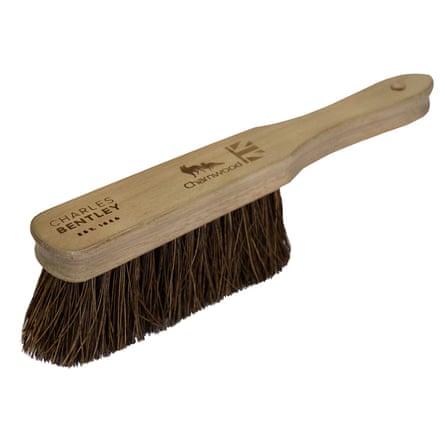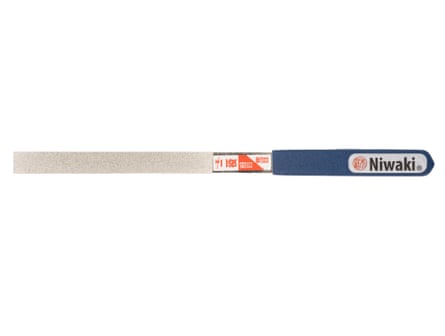Garden tools have it rough, there’s no getting around it. Dragged through the mud, blunted by branches, clogged with clippings and exposed to some of the most wearing of environmental conditions – namely rain, sap and soil – you can’t help but feel the average spanner gets an easier ride than a pair of secateurs.
And yet gardening tools are among the most cherished and expensive of maintenance equipment, with popular brands such as Niwaki and Felco catering to a booming luxury market with embellished components such as leather and rattan handles, and blades forged in the mountains of Yamagata, Japan.
An estimated 27 million people are now actively gardening in the UK, and households are spending more on gardening tools than ever. And as I wrote in my roundup of the best secateurs this year, such is the bond between gardener and trusty hand tool that they often become companionable, personally prized possessions. So what can you do to prolong the life of a treasured border spade, hedge trimmer or pair of beloved secateurs? Here are a few tried and tested tips from the hard-grafting experts, and some products that will make light work of a messy job.
Cultivation tools
Having worked and volunteered in numerous large-team gardens over the years, I’m always intrigued by the policies head gardeners employ for the preservation and storage of general-use gardening tools. While some are content with a quick brush down after use, others are positively draconian.
Millie Souter, head gardener at the Plant Library in Hertfordshire, tells me she’s strict about maintenance. Tools such as border spades and trowels are washed and rinsed clean under a hose after every use, and each has a designated space marked out in the potting shed. “It just makes it a pleasure to be able to grab a tool that’s clean, ready to use, and you know where it is!” she says. For the clean-down, she recommends a reliably stiff brush, with good examples being Tinker and Fix’s garden tool brush and Charnwood’s bassine hand brush. For washing multiple tools in one go, you can half-fill a garden trug with water – such as a flexi tub – and, provided it’s free of soap, irrigate thirsty trees and shrubs with it once you’re finished cleaning

Garden tool brush

Charnwood bassine hand brush

Flexi tub, 42l
Any tool centred around a blade – or, most commonly in gardening, a pair of blades – requires a little additional attention. But while whole manuals have been written on the detailed maintenance of blades, the process really needn’t be comprehensive, as there are but two perils to prevent: bluntness and rust.
In horticulture, the cleanliness and sharpness of a blade – whether a pair of secateurs, shears, a pruning knife or scythe – can greatly affect the work at hand: bruised blades bruise plants, just as dirty blades advance disease. For regular, day-to-day cutting-tool cleanups – particularly for secateurs and hand shears – removing grime is hugely important.
A spray lubricating and cleaning oil, such as WD-40 or Oregon’s biodegradable MX14 cleaner, applied to all moving parts, crevices and corners (blades, nut, spring, etc), will break down the residue left by sappy plants, mulches and soil. Spray, allow to soak and then wipe away with a washable cloth such as a duster, or Minky’s more sustainable all-purpose bamboo cloth. (Or you could just rip up and repurpose old T-shirts, as I often do.)

WD-40 spray

Oregon biodegradable MX-14 workshop liquid cleaner

Minky bamboo all-purpose cleaning cloth, pack of nine
For further daily blade sprucing, Souter recommends Niwaki’s Mini Clean Mate, a pocketable sap and grime eraser that you run over the blades and nut after use. “It’s really good and really quick – you can just use it like a rubber to remove gunk.”

Niwaki Mini Clean Mate
For a deeper clean, many models of secateurs and shears can be taken apart fully, making them easier to then sharpen. Katy Merrington, head gardener at the Hepworth Wakefield, enjoys showing her group of garden volunteers how to dismantle and clean secateurs, loosening the nuts with a spanner or socket wrench and cleaning everything with a rough scourer or wire wool, before sharpening them.

14-piece metric socket wrench set

Fairy steel wool scourers
“Sharpening tools is a funny thing that falls into the same category as barbecuing – for some reason, people think it’s a particularly manly job. Volunteers often suggest bringing their husbands in to do it, so I take a particular pride in teaching people how to do it themselves.” They do this at least once a year, Merrington explains, typically in winter, making use of time indoors. “There’s nothing worse than ending up with tools that just sit there unused because you haven’t bothered to sharpen and maintain them.”
Merrington describes how they run the secateur blades along a sharpening stone, or whetstone, at the existing angle of the blade’s slant, by hand. “We then test the sharpness on a piece of paper or on plant material.” A small to medium whetstone works best for this, including Felco’s fancy diamond sharpener and Opinel’s 10cm sharpening stone. Niwaki offers a set of three stones, differing in grit coarseness, and camellia oil for a clean finish afterwards.
after newsletter promotion

Felco diamond-coated sharpening stone

Opinel 10cm sharpening stone

Niwaki sharpening stones, set of three
When it comes to secateurs, a holster – however gawky looking – will ensure your pair is stowed clean and dry whenever not in use, greatly extending its shelf life. Felco’s 910 belt-looped holster has certainly kept mine from going missing over the years.

Felco 910 leather holster
Electric tools
The No 1 rule with electric power tools, including lawnmowers and hedge trimmers, is to store them in a dry environment, as dampness can lead not only to corrosion and short-circuiting but also to associated safety risks.
So a leak in the shed or outdoor storage box, however small, is worth patching right away. As for cleaning and sharpening, electric tools can generally be treated similarly to petrol machines, says Matthew Walker of Upton and Walker Gardening, a garden maintenance and design company based in south-east London.
Walker says he cleans his electric mower after every use, removing any debris. “I tip it up and clean out the underside with a hand tool, or sometimes a blower,” he tells me. As with all electric tools, it’s important to disengage the battery before any cleaning or maintenance. Most important for mowers, says Walker, is to keep the blade sharp, otherwise “it just tears the grass and it looks crap after a few cuts”. This can also lead to the blade becoming damaged. He uses Niwaki’s twin diamond file for this, taking out any nicks. “I probably replace the blade entirely once every season, too,” he says.
But he recommends taking hedge trimmers to be resharpened professionally by a specialist. “You can do it at home, but it’s quite technical, so it can be better to send the machine off,” he says. After cleaning or sharpening his tools, Walker applies Stihl’s SuperClean lubricant spray, which gets rid of the sticky resins that can build up.

Niwaki twin diamond file

Stihl SuperClean spray
Wheelbarrows
Scrape clean after use and don’t leave out over winter – find space in the shed or cover with a tarpaulin when not in use.
Gloves
A cold machine wash once a month will keep fabric-based gloves in good condition.
Wooden-handled hand tools such as hoe, rake or trowel
A fine-grain sanding and a light coating with boiled linseed oil will help prevent the degradation of wooden handles.

Extra fine metal and wood hand sanding sheets, five pack

Bartoline boiled linseed oil
For more, read the Filter’s guides to the best secateurs and the best pressure washers
Matt Collins is a garden, nature and travel writer, and head gardener at the Garden Museum in London

 1 month ago
45
1 month ago
45

















































